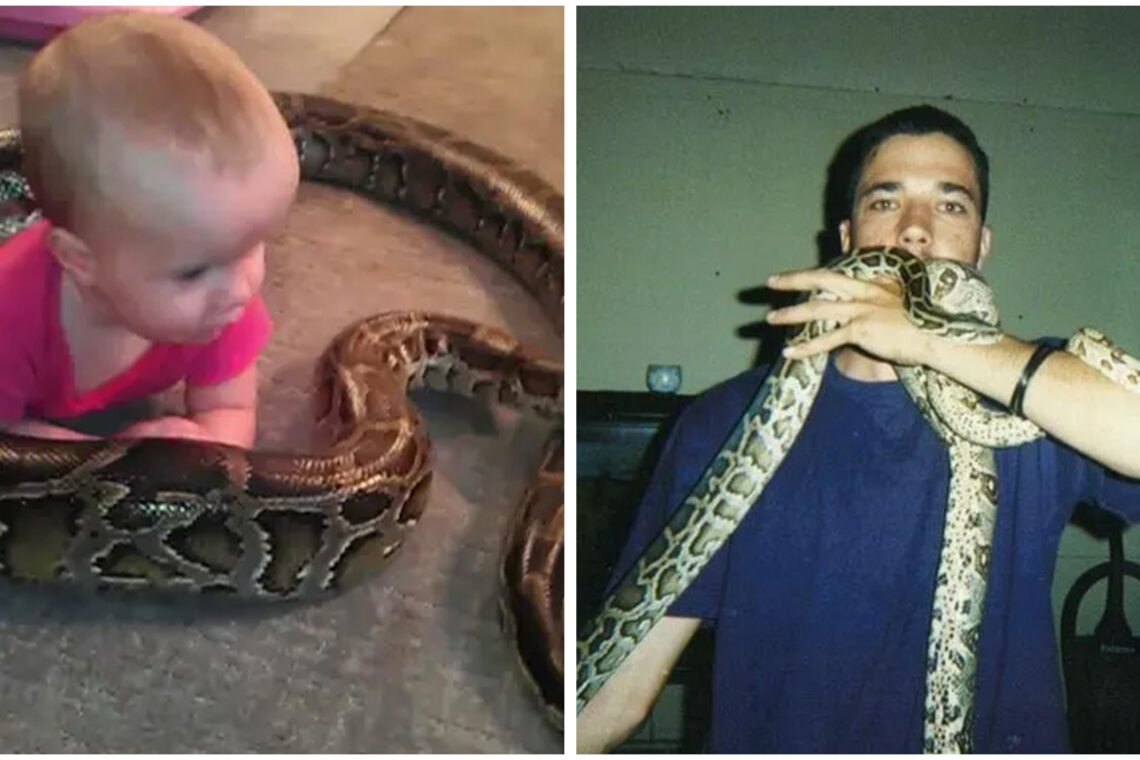
In a world dominated by images of pets like cats and dogs, there’s a growing fascination with more unconventional companions. While social media frequently showcases kids with their fluffy pets, one family in Michigan stands out for their unusual choice of a family pet: a massive Burmese python.
The snake, named Nay-Nay, is no ordinary pet. It’s a 13-foot-long python, and despite its size and potential danger, it shares a home with Jamie Guarino and his three daughters in White Lake, Michigan. Jamie, the father of the household, has had Nay-Nay since it was a tiny baby snake. Now, the once-small reptile has grown into a formidable presence, capable of inflicting serious harm in a matter of moments. Still, Jamie treats the snake like a cuddly companion, often allowing it to interact with his children, including his youngest daughter, who was just 14 months old when a controversial video of them together was shared online.
The footage shows Nay-Nay, the giant python, slithering over the toddler, who is lying on the floor. The video quickly gained attention and sparked a mix of concern and admiration across social media platforms. Many viewers expressed their worry, fearing that the snake, despite its gentle demeanor, posed an inherent danger to the child. “This guy has a love for his snakes, which is perfectly fine, but it’s made him blind to the fact that it remains a dangerous animal, especially towards a baby,” one comment read, highlighting the potential risks associated with such interactions.
Jamie, who has been handling snakes professionally since he was a teenager, responded to the backlash by defending his actions. He believes that people’s reactions to the video are largely driven by ingrained fears of snakes. “When people see this clip, they mostly react with fear or negativity. And I don’t understand why,” he explained. “This is an embedded fear, and I think people are brainwashed. Snakes can be, and are, loving animals.” For Jamie, the issue isn’t that people are criticizing him but that they fail to see snakes for what they truly are: intelligent and often affectionate creatures.
The video, however, has not only sparked debates but also garnered support from many viewers. Some online users pointed out that the python’s behavior in the video seemed calm and non-threatening. “Snakes are inquisitive animals, and they are also very affectionate despite the mean reputation,” one commenter shared, expressing admiration for Jamie’s deep understanding of the reptile world. “Listen to this guy folks, snakes are NOT what you think they are.”
Further discussions centered on the idea that, as long as the snake is not provoked or hungry, it should be safe for children to be around. Proponents of this view argue that animals like snakes should not be judged solely by their reputation but understood based on their behavior and the environment they are in. “Have massive amounts of respect for this guy,” one supporter wrote. “He’s a professional. He knows his snakes, and you can clearly see the snake is chill, not particularly interested in the little girl but more interested in having a look around.”
Despite the support from some viewers, the video didn’t go unnoticed by authorities. In 2015, the Oakland County Prosecutor’s Office decided to investigate the situation, suspecting potential child neglect or abuse. The concern stemmed from the perceived danger of allowing such a large and powerful snake to interact with a young child. The investigation was requested by the Department of Human Resources, raising questions about whether the actions were responsible or reckless.
The incident brings to light a larger issue regarding public perceptions of exotic animals and the risks associated with keeping them as pets. While Jamie has spent years working with snakes and has built a deep bond with his pet, others remain concerned about the unpredictability of wild animals. Even well-trained and seemingly docile snakes can exhibit dangerous behavior under certain conditions, especially if they feel threatened, startled, or hungry.
This ongoing debate highlights the contrasting views between pet owners and animal experts who are deeply familiar with exotic species, and the general public who may have little understanding of the species. On one hand, there is an argument for the responsible handling and care of reptiles, showcasing their intelligence and ability to form strong bonds with their owners. On the other hand, there’s a natural apprehension that comes from the unknown, with many people viewing large snakes as inherently dangerous regardless of the handler’s experience.
While some see Jamie’s interactions with Nay-Nay as a display of trust and affection, others view it as an irresponsible risk that endangers both the child and the community. Ultimately, the debate over whether exotic pets like pythons belong in family homes is not just about animal behavior but about the balance between human emotions, education, and safety.
Jamie’s argument revolves around his belief that people’s fear of snakes is rooted in misinformation and stereotypes, which can lead to an unfair demonization of the creatures. He urges viewers to educate themselves before passing judgment on pet owners who keep reptiles. “Don’t judge based on fear or something you don’t understand,” he said. “Snakes can be, and are, loving animals.”
In the end, Jamie’s relationship with Nay-Nay and the attention surrounding the video may serve as a valuable opportunity to challenge preconceived notions about snakes and their place in human society. Whether you agree with Jamie’s perspective or not, the discussion raises important questions about the nature of human-animal relationships and the role of education in fostering understanding.